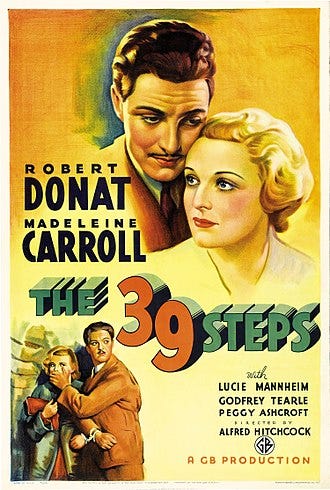
The 39 Steps (1935). Grade: B-
You’ll be impressed by the bridge. It’s a very big bridge. We’ll get to it later.
Robert Donat is attending a music-hall/vaudeville show in London. A gun goes off, and mayhem ensues (it’s pretty funny when fleeing patrons just completely overrun some cigarette girls in the doorway). As Donat leaves, an attractive lady with an exotic accent asks if she can accompany him home; she’s terribly frightened.
When she gets there, she avoids being seen in windows; she’s hiding from someone. Two shady-looking men on the street below. She explains that she’s a good spy, and they’re bad spies, and they’re gonna get her. Donat agrees to let her stay the night (quite gentlemanly, too — he sleeps on the couch).
In the morning, she staggers out of another room, mutters a warning, and dies — there’s a knife in her back. And those same two shady-looking men are still waiting outside, presumably to get Donat next. They got in somehow, killed her, didn’t kill him, but plan to as soon as he walks outside in broad daylight when there’s probably bystanders.
In his worshipful Criterion essay, Scottish critic David Cairns writes, “this is a pretty bold deployment of sheer nonsense, but his shamelessness is matched by [Hitchcock’s] magician’s sense of how to divert the audience’s mind from pondering implausibilities.”
OK. I’ll grant that usage of the word “magician,” since it refers to an amusing or eye-catching distraction; and the next scene is funny. But it might have been the writers what thunked it up (Charles Bennett and Ian Hay). Not EVERYTHING good in Hitchcock movies was his alone.
Anyways, the scene is cute — Donat catches hold of the milkman, and wants to buy his coat/hat for a disguise so he can slip out unnoticed. The milkman’s having none of it, and thinks Donat’s daffy for talking about murderers outside. So Donat switches his story, saying he spent the night with a married woman, and the creeps outside are her brother & husband waiting to beat him up. THEN the milkman’s more than happy to give Donat the hat/coat for free! Saying “maybe you’ll do it for me next time.”
Ah, getting away with adultery via Paying it Forward!
Cairns is amusing on the geographical absurdities of the plot; one scene with Donat in a very specific Scottish location (that bridge) is follwed by another with him in the Scottish highlands, 100 miles away. He’s also funny on how Donat is identified as Canadian; “it can’t be his accent.” Cairns tells us that British films frequently cast popular American actors as Canadians, so the movies would make more money in America. (Although Donat is very British.)
Eventually, Donat is not only running from the cops (who think he stabbed the exotic lady in his flat), he’s also running from nasty bad spy guys who want to get rid of him. This plot would be lifted almost verbatim for 1959’s North by Northwest (written by Ernest Lehman that time around); I got news for ya, Hollywood’s been doing the remake game for a long time.
That movie’s better than this one; it has better bad guys (James Mason, Martin Landau), a great Bernard Herrmann score, and Cary Grant. But this one’s got its good moments.
One’s in a hotel. The baddies handcuffed Donat to a lovely lady who hates his guts (Madeleine Carroll); naturally, this means they end up fleeing together, still handcuffed. They take shelter in the hotel, hiding the cuffs, and pretending to be married. The hotel manager’s wife knows they’re lying, and loves it! She’s all too happy to shove them into bed together. There’s no lech like an old Scottish lady!
And another, strangely wistful sequence, where Donat pays a farmer (John Laurie) to let him crash in a back room. The farmer’s wife is considerably younger, and gives off a vibe of being trapped in a loveless marriage to a mean, dull man. There’s a sense that Donat’s witnessing the start of the next 30 years of misery — or however long it is until the husband dies. The young wife is Peggy Ashcroft — who’s exceptional as Mrs. Moore in A Passage To India, 49 years later.
Interestingly, per Turner Classic Movies, Donat just flat-out hated America. He absolutely refused to go there. When he did Hollywood films, he would only do them if they were filmed in Britain. TCM doesn’t say why this is, either, so your guess is as good as mine. Dumped by an American flame? His dog fell into the Grand Canyon, or off the Empire State building? Who knows. In any case, he’s a charming, likable guy, and Carroll’s very good with him in their short scenes together.
And then, yes, there’s the bridge. We won’t forget that! It’s the Forth Bridge, about 1.5 miles from end-to-end, across a large fjord near Edinburgh. First opened in 1890. It looks very cool in this movie; that might be due to credited cinematographer Bernard Knowles, or it might be a “second unit” (a smaller film crew separate from the main one, assigned to go get specific visuals). Who know who shot it? Looks good.
Incidentally, reading about the bridge taught me something I’ve always been curious over — how DO you build bridges with supports that go under water? I guess I always assumed that you just sent divers down to do it? I was wrong!
Per the Wiki page, this used “cofferdams” and “caissons.” A cofferdam is where you dam up part of the river/fjord/whatever and pump the water out. A caisson is something you lower into the water, like this:

Now, isn’t that clever! I can’t believe I thought it was all divers. In 1890? With those big suits that had diving helmets with air tubes attached? That’s a pretty silly notion.
And it’s a pretty silly movie. But easy enough to enjoy.



